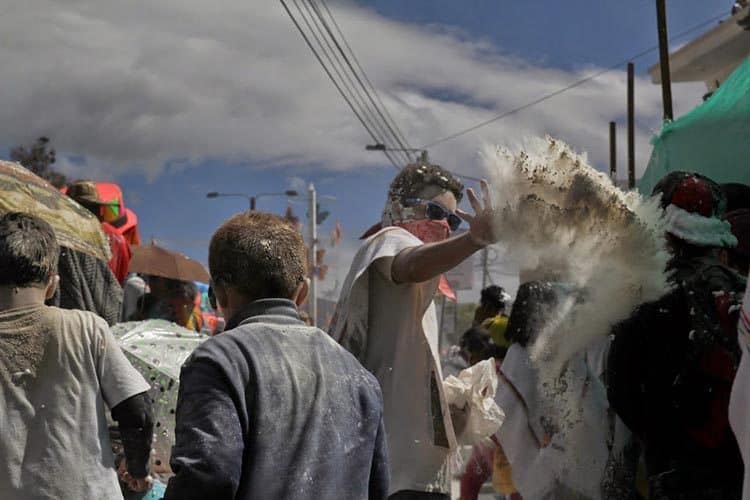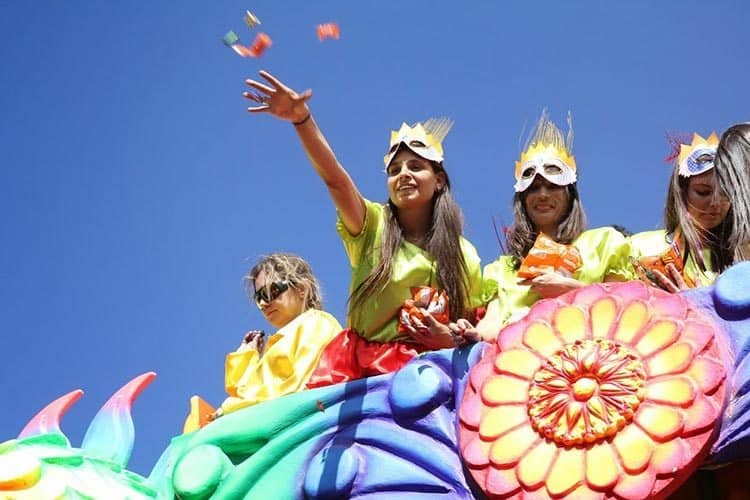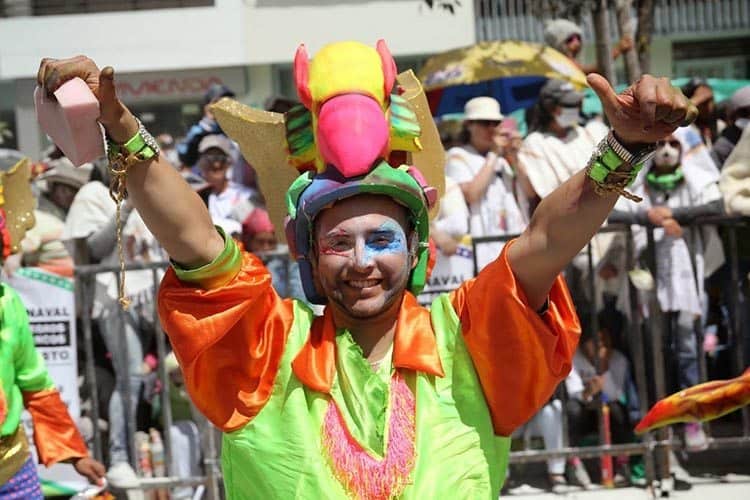
Surviving the Carnaval de Negros y Blancos in Colombia
By Ski Krieger
I step out into the one-plane airport of Pasto, Colombia, very near the Ecuadorian border. Before I can react, before I even reach the taxi stand, there’s an ambush.
A group of teenagers cackle as they strafe the line of expectant family members and private taxi services, each armed with two Cariocas, long, narrow aluminum cans containing something akin to shaving cream, the basic-issue armament of the Carnaval de Negros y Blancos participant.
I duck behind an old woman, who takes the brunt of the fire. This will prove to be the only time I feel ashamed about using the elderly for protection. With their broad frames and slow movements, they really do provide the best cover.
It’s getting dark as I step out of my hotel to take place in the nocturnal revelries. I’m wearing my nice shoes and nice jeans, and don’t even think twice about it. I’ve read the Wiki on this thing. Today there’s a nice parade, tomorrow we’ll paint each other black, and the last day we’ll throw talc and foam and make a mess – the assault on the airport was an isolated incident. Tonight should be good clean fun.
Like all good festivals, the Blacks’ and Whites’ does not abide by its own rules. I’m no more than ten steps outside my hotel when a family with two children eyes me head to toe in bemusement before they each whip out the Cariocas from behind their back and douse me thoroughly. While I’m desperately trying to clear the foam from my eyes, nose, ears and mouth, a window rolls down from a passing car and a talc-bomb catches me square in the chest. The doorman of my hotel laughs devilishly as I look around, trying to figure out what just happened.

One block further and a group of concerned-looking teenagers approaches me. Seeing how unprepared I am, they take pity and buy me my own carioca as well as a pair of sunglasses – the foam can sting your eyes, they explain to me. “No shit”, I tell them in my best Spanish. I follow them on their route, glad for the protection a few extra bodies can afford.
But their good nature is short-lived, or maybe entirely a ruse. They accompany me like bodyguards for a short time, leading me into the middle of one of Pasto’s two large squares dedicated to the carnival. As we push through throngs of people, I try to memorize the way back to my hotel, constantly wiping foam off of my sunglasses.
Just when we reach the heart of the beast, the kids loudly call attention to my gringo presence. I will never see them again, as it takes nearly ten minutes to de-foam and de-talc myself, blindly stumbling through thousands of people to find shelter. This is the nature of warfare in Pasto.
January 5th: Blacks’ Day
I’ve planned a route for a morning stroll, hitting many of Pasto’s beautiful cathedrals and sanctuaries and also scouting out a good spot to view tomorrow’s Great Parade. I wear the same clothes, my battle gear, which will become impossibly ruined. With some paranoia I skulk about, peeking around corners, keeping an eye out for adolescents with cariocas. But they are still asleep, and the first to rise are the kind ones, the elderly and families with young children, who want to enjoy themselves before the mayhem starts.
I take a moment to breathe the cool, mountain air. A group of Colombianas, giggling, points me out. They turn around, conferring, then one of them slowly strides up to me. I stand stock-still; my conception of the carnival was more or less receiving undue attention from beautiful Colombian girls while parades and parties took place in my peripheral vision, and it seems to be coming true.
She comes in for a kiss, cradling my face in her hands. There is a cold, oozing sensation, and as she pulls away before making contact I realize that her hands were overflowing with black paint. The 5th is officially in full swing as each of her friends more or less slap me with a handful of the same.
Later in the afternoon my cousin and photographer Jordan arrives in town. His wide-eyed expression and foam-covered bag communicate that he’s had a comparable experience to my own arriving into the city. We stroll around, paint and get painted, drink beers and talk with various groups, and enjoy warm Andean hospitality.
Then, suddenly, the debauchery switches on. We come to realize that all the descriptions of the festival are true until about three in the afternoon, when the fabric of society dissolves under the chemical duress of twenty tons of shaving cream.
From Beer to Aguardiente
Street vendors who have been hawking cold beers now change to aguardiente, the local anise-flavored liquor. The painting changes from delicate strokes by attractive women to more intrusive attacks. A boy no more than twelve years old sneaks up behind me and gets my whole nose and mouth with blue paint, which I will taste for a week. And then the Cariocas come out.
Back at the hotel, we ask the security guard if it can get any crazier. He has worked outside the hotel every Carnaval for five years, which makes him a sage old veteran deserving of his epaulets. He laughs at us. “Oh, that’s nothing, compared to tomorrow. You’ll want to buy a mask for your nose and mouth.”

And he’s absolutely right. The next day, the 6th, is the Whites’ Day and also the day of the grand parade, which starts early and goes for five or six hours under the hot sun. In Spanish it’s the Gran Desfile, which reads to American eyes like the Great Defiling, which is more or less what it is.
Aguardiente hits the streets before the sun, and people who have grown impatient waiting for the parade to start get in massive carioca, flour and talc fights.
Clouds of white massive enough to blot out the sun become a regular affair. It’s a study in the chain reaction – one sour look, one misfire of a carioca and suddenly a whole city block looks like the local Gillette factory had an accident.
Tourists and the police patrolling the cordons are particular targets, though with so many people packed into such tight areas it is difficult to aim accurately.
Finally, the parade arrives. This is the reason why the festival is commemorated by UNESCO as a masterpiece of intangible cultural heritage, and it does not disappoint. Hundreds, perhaps thousands of colorful floats that have been the whole year in the making pass by, gradually increasing in size from enormous heads mounted on the shoulders of grunting, sweating men to converted buses and sixteen-wheelers.

These are punctuated by musicians, dancers, circus performers, and scantily clad Colombianas. There are nearly half a million people taking it all in, packed tighter than sardines, hanging from second-story balconies and sitting on towels wrapped over razor-wire walls.
Fifty-pound paper mache political candidates box one another while KISS cover bands play local Andean music and women distribute smooches and candy. Gabriel Garcia Marquez, who passed earlier this year, receives special attention with two or three large floats in his honor.
It’s an amazing spectacle until the sun starts to dip. Everybody knows what that means, including us. The rules that hold this fragile peace together will soon crumble. The apocalypse is coming.
A Talc-River Runs Through Colombia’s Carnaval
Fearing the end of days, we spend our last night at a salsa bar three stories above the main plaza. Looking down, we can see nearly fifty thousand people. Live concerts of a salsa-reggae mixed-genre blare out at a hundred decibels.
Generally, a salsa bar is a good place to hang out off the beaten track in Colombia. All the girls want a dance, and we embarrass ourselves and our nation thoroughly. Occasionally, we lose sight of the crowd roaring beneath us as a dusty white cloud permeates the square or a snowball of foam manages to make it up thirty feet to our position. But that’s the Carnaval. Cover your ears, your eyes, and your drinks.
And with that, the festival is over. We creep out on the 7th in our battle gear, expecting the same no-rules surprise attacks as the previous three days, but we look like fools. Everybody is dressed in business- and nicer casual-wear, nobody has sunglasses, and most of the destruction has already been washed away in an ever-swelling river of chalky talc and flour.
An old woman leans up against a tree, bracing herself – she has an actual fire hose over her shoulder, and she is power-washing the façade of her fabric store. Her stream joins the rest of the white water, which will flow downhill into the ravines of the Andes, carrying away the last trace of the confluence of Blacks and Whites until next year.
Ski Krieger is a graduate student in Providence RI, whose travel writing has appeared in TravelMag UK and the University of Chicago magazine. Jordan Allred is a photographer and journalist for the Deseret News in Salt Lake City, Utah.
- Missouri Sports Travel Adventure: From Landmarks to Ballparks - January 21, 2026
- What First-Time Visitors Get Wrong About Visiting Iceland - January 15, 2026
- Bareboat Charter vs all-inclusive Crewed: Which Luxury Charter Fits You? - December 29, 2025







